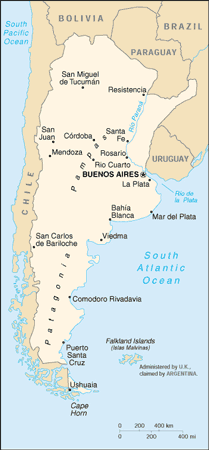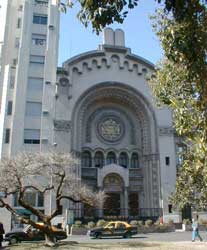 |
| B"H |
|
Visite nuestro sitio/Visit our home page: |
by Rebecca Weiner
Argentina is the second largest nation in Latin America and boasts the largest Jewish community in the region. From an open door policy of immigration to the harboring of Nazi war criminals, Argentina’s Jews have faced periods of peaceful coexistence and periods of intense anti-Semitism.

After the expulsion from Spain in 1492, conversos (or secret Jews) settled in Argentina. Most of these immigrants assimilated into the general population and, by the mid 1800's, few Jews were left in Argentina.
Argentina gained its independence from Spain in 1810. Bernardino Rivadavia, Argentina’s first president, gave support to policies that promoted freedom of immigration and respect for human rights, i.e., he officially abolished the Inquisition. In this atmosphere of tolerance, a second wave of Jewish immigration began in the mid-19th century with Jewish immigrants arriving from western Europe, especially from France.
In 1860, the first Jewish wedding was recorded in Buenos Aires. A couple of years later, a minyan met for the High Holiday services and, eventually, the minyan became the Congregacion Israelita de la Republica.
In the late 19th century, a third wave of immigration fleeing poverty and pogroms in Russia, and other Eastern Europe countries, moved to Argentina because of its open door policy of immigration. These Jews became known as "Rusos" and became active in Argentinian society.
In 1889, 824 Russian Jews arrived in Argentina on the S.S. Weser and became gauchos (Argentine cowboys). The gauchos bought land and established a colony, which they named Moiseville. Due to lack of funding, the gauchos appealed to Baron Maurice de Hirsch for funds and the Baron subsequently founded the Jewish Colonization Association. During its heyday, the Association owned more than 600,000 hectares of land, populated by more than 200,000 Jews. While many of these cooperative ranches are now owned by non-Jews, Jews continue to run some of the properties.
Between 1906 and 1912, Jewish immigration increased at a rate of 13,000 immigrants per year. Most of the immigrants were Ashkenazi Jews from Europe, but a number of Sephardic Jews from Morocco and the Ottoman Empire also settled in Argentina. By 1920, more than 150,000 Jews were living in Argentina.
Anti-Semitic attacks against Jews were infrequent in Argentina before World War I. Following the Russian Revolution, between 1918 and 1930, anti-revolutionary feelings developed into full-blown anti-Semitism against the Rusos. From January 7-13, 1919, a general strike in Buenos Aires lead to a pogrom against the Jews. Many were beaten and had their property burned and looted.
Despite anti-Semitic actions against the Jews and increasing xenophobia, Jews became involved in most sectors of Argentine society. Still they were unable to be work in the government or military and so many became farmers, peddlers, artisans and shopkeepers. Cultural and religious organizations flourished and a Yiddish press and theater opened in Buenos Aires, as well as a Jewish hospital and a number of Zionist organizations.
Juan Peron’s rise to power in 1946 worried many Jews because of he was a Nazi sympathizer with fascist leanings. Peron halted Jewish immigration to Argentina, introduced Catholic religious instruction in public schools and allowed Argentina to become a haven for fleeing Nazis. On the other hand, Peron also expressed sympathy for Jewish rights and established diplomatic relations with Israel in 1949. Since then, more than 45,000 Jews have immigrated to Israel from Argentina.
Peron was overthrown in 1955, which was followed by another wave of anti-Semitism. In 1960, Israeli agents abducted Adolf Eichmann from a Buenos Aires suburb. The Eichmann trial in Jerusalem, in April 1961, aroused further anti-Jewish sentiment in Argentina.
Argentina was under military rule between 1976 and 1983. During this period, Jews were increasingly targeted for kidnapping and torture by the ruling junta; about 1,000 of the 9,000 known victims of state terrorism were Jews. According to the Jerusalem Post, the Israeli government had a special agreement with the Argentine government to allow Jews arrested for political crimes to immigrate to Israel. Once the military’s power waned in Argentina, anti-Semitic attacks also declined.
In 1983, Raul Alfonsin was democratically elected as president of Argentina. Alfonsin enjoyed the support of the Jewish population and placed many Jews in high positions.
Carlos Saul Menem was elected president in 1989, his Arab origin and support of Peron worried the Jews, however, he did not follow in Peron’s footsteps. Menem appointed many Jews to his government, visited Israel a number of times and offered to help mediate the Israeli-Arab peace process. After a Jewish cemetery was desecrated in Buenos Aires, Menem immediately expressed his outrage to the Jewish community and, within a week, apprehended those responsible.
President Menem also ordered the release of files relating to Argentina’s role in serving as a haven for Nazi war criminals. A law against racism and anti-Semitism passed in the Argentine parliament in 1988.
Despite Menem’s sympathetic policies and a democratic regime, the Jews of Argentina were targets of two major terrorist attacks. The Israeli Embassy was bombed in April 1992, killing 32 people. In 1994, the Jewish community headquarters (AMIA) in Buenos Aires was bombed, killing 87 people and wounding more than 100 others. The community’s archives were destroyed in the bombing and the event left many emotionally scarred. Though Iran was suspected of involvement, with the help of Argentine police, the culprits have never been found. In 2005, an Argentine prosecutor said the AMIA bombing was carried out by a 21-year-old Lebanese suicide bomber who belonged to Hezbollah.
Jews are active in all sectors of Argentine society and many are prominent figures in the arts, film, music and journalism. Some influential Argentine Jews include: writer Jacobo Timmerman, owner of a local newspaper who campaigned for human rights; Rene Epelbaum, who founded a protest group for mothers of political prisoners; pianist Daniel Barenboim, and Cesar Milstein, the 1984 Nobel Prize recipient in medicine.
Throughout Argentina’s history, Jews have held a large stake in the country’s fur, textile, chemical, electronics and auto industries. Both Banco Mercantile and Banco Comercial were founded by Jews. On the other hand, Jews are still absent from the high ranks of the military, foreign ministry and judiciary.
Poverty in Argentina is on the rise, affecting Argentina’s middle class, which is losing its small and medium sized businesses. Many Jewish business owners have lost their shops and are unable to pay membership or tuition fees to local Jewish institutions and synagogues. These communal institutions now face declining membership and budgets to maintain their activities and services. A much larger percent of the bugets of these oranizations now has to go to emergancy economic relief. In response to the economic decline and lack of funds, the Joint Distribution Committee and the Jewish Agency are training new, young lay leaders to rebuild the community and run the local institutions.
The economic situation has caused about 10,000 Jews to leave Argentina in the last few years. About 6,000 emigrated to Israel. Jewish community leaders are hoping that the election of a new presdient will bring economic stability and cease emigration .
Argentina’s Jewish community numbers more than 250,000; of that 200,000 live in Buenos Aires, 20,000 in Rosario, 9,000 in Cordoba and 20,000 in other small, rural communities, including some areas in the Sante Fe province. There are also signifcant numbers of Jews in the cities of Concordia, La Plata, and Mar del Plata. The majority of these Jews are Ashkenazi, about 15 percent are Sephardic. Nearly all the Jews speak Spanish — Ladino and Yiddish are rarely spoken. The community is not growing and many young Jews are immigrating to other countries.
Argentina’s Jews have numerous Jewish community organizations. The DAIA (Delegacion de Asociaciones Israelitas Argentinas) was founded in 1939 as the political arm of the Jewish community. The DAIA protects Jewish rights and represents the community in the government. Another organization, the AMIA, originally an Ashkenazic mutual-aid society that provided health and human services to Argentina’s Ashkenazi population, now serves the country's entire Jewish community.
Most of Argentina’s synagogues are traditional, lying somewhere between Conservative and Orthodox. Buenos Aires has 50 Orthodox synagogues, 21 Conservative synagogues and a few Reform synagogues. Most of the synagogues built before World War II are still in use today.
The Conservative movement became strong in Argentina in 1958 after Rabbi Marshall Meyer took control over Communidad Bet El, the country’s first Conservative synagogue, located in Buenos Aires. His enthusiasm attracted many young adults. Meyer became involved politically, gathered information about political prisoners and published the material in the newspapers.
President Alfonsin appointed Meyer to a government commission that investigated the disappearances of Jews in the military regime. In 1984, Marshall left the community and moved to New York, where he currently serves as the Rabbi for B’nei Jeshrun, another vanguard synagogue in the Conservative movement.
Today, Communidad Bet El also has a day school and attendance on a regular Saturday morning reaches up to 800 worshipers.
Argentina boasts more than 70 Jewish educational institutions, including kindergartens, day schools, elementary and secondary schools. More than 60% of Jewish Argentine youth attend one of these institutions. In Buenos Aires alone, 17,000 Jewish children study in the Jewish educational system
Communities in other cities also have Jewish social clubs, Sociedad Hebraica for Ashkenazi Jews and Casa Sephardi for Sephardic Jews. Maccabe Sport Federation is also active in Argentina. Plays are performed in Yiddish, Spanish and Hebrew in a number of Jewish theaters across the country.
There are also 18 Jewish cemeteries located in Argentina, of those seven are still active. One can find Jewish cemeteries in Buenos Aires, Cordoba, Parana, La Plata, Colinas del Tiempo, Rosario and Sante Fe. La Tablada cemetery in Buenos Aires has been vandalized in anti-Semitic attacks in 1994. Bronze objects were stolen from more than 150 graves.
While Argentina's Jewish population has many community outlets, one quarter of the population is living below the poverty line. Even well-educated young people are finding it next to impossible to find a job. There are groups in Argentina trying to irradicate this problem. Alianza Solidaria (started by the JDC) is an organization trying to fight poverty among Jews. The Tzedaka foundation is another organization that devotes its efforts solely to helping the impoverished Argentinian Jews.
Even those wealthier Jews who try to help the poor have been unable. In 1998, Banco Patricios collapsed, taking with it millions of Jewish dollars. The Banco Mayo also failed to help the situation as it too went bankrupt in 1999. Because of these circumstances, many once wealthy Jewish organizations are now unable to give funding to charity groups. AMIA, a major benefactor for social programs, is now trying to pay off a $26 million debt.
Much of Buenos Aires Jewish life centers around the Once district (pronounced on-say). One of Once’s well known synagogues is Yesod Hadat, founded in 1932 by Jews from Aleppo, Syria. It is located on Lavalle 2449.
 |
Once also has a Jewish cultural center, which hosts concerts, lectures and a high school, located at Sarmiento 2233. Other Jewish clubs include Hacoaj and C.A.S.A. Sefardita have a range of sports and cultural activities.
Argentina’s oldest synagogue, Congregacion Israelita de la Republica Argentina, is known as "Libertad" because it is located at Libertad 733 in Buenos Aires. The Libertad was dedicated in 1932 and houses a small Jewish museum, which a good collection of photographs and Jewish ritual objects.
The Argentine branch of the Jewish Theological Seminary, the Conservative movement’s Rabbinical School, opened in 1962 in Buenos Aires and trains Conservative Rabbis from all over Argentina and Latin America. In 1992, the first woman was ordained by the seminary. The seminary acts as a center for interfaith dialogue, hosts a high school and a graduate school and offers adult education lessons and seminars for the community.
Buenos Aires has one of the world’s four remaining Yiddish daily newspapers, others are found in Paris, Tel Aviv and Birobidjan, in Siberia.